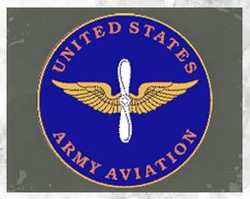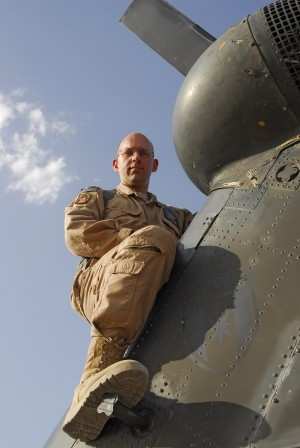Weather In Adder, Iraq, Makes For Challenging Flying
 Maj. Anthony Meador is near the end
of his third tour in Iraq as an Army aviator. Having served in
Baghdad in 2004 and at Joint Base Balad in 2007, he now commands
Company C, 1st Battalion, 52nd Aviation Regiment, a Fort
Wainwright, Alaska, unit attached to 2nd Battalion, 104th Aviation
Regiment, 28th Combat Aviation Brigade in Adder, Iraq.
Maj. Anthony Meador is near the end
of his third tour in Iraq as an Army aviator. Having served in
Baghdad in 2004 and at Joint Base Balad in 2007, he now commands
Company C, 1st Battalion, 52nd Aviation Regiment, a Fort
Wainwright, Alaska, unit attached to 2nd Battalion, 104th Aviation
Regiment, 28th Combat Aviation Brigade in Adder, Iraq.
During his first tour, Meador served as a medical evacuation
pilot during some of the most intense fighting in the war. "We were
slammed in 2004, and in April things got really bad," he recalled.
"One night, we evacuated 44 soldiers in two and a half hours on six
Black Hawks. We had burns, gunshot wounds, shrapnel wounds. ... The
2/5 Cavalry got ambushed in Baghdad's Sadr City neighborhood. The
whole year was nonstop for all of us."
Meador returned home in 2005 to his wife and his first baby boy,
who is now 5. He had almost two years of stateside duty before
returning to Iraq with the surge of troops in 2007. "I was
executive officer of a [general support aviation battalion] based
in Balad, so I flew every kind of aircraft we had," Meador said.
"With the surge, the operating tempo was high."

Maj. Meador U.S. Army Photo Credit Neil
Gussman
His first two tours were filled with high-intensity,
around-the-clock operations, the pilot recalled, but the weather
was great. "In Baghdad and Balad, the weather was not an issue," he
said. "It was sunny all the time -- no dust storms." But that's not
the case here.
The intensity of operations here often is lower, Meador
explained. "The weather shapes every aspect of our mission
planning: weather here, weather at the destination, weather along
the route. We are constantly updating our planning based on the
weather."
Difficult weather forces tough decisions with medical evacuation
flights. One of the toughest decisions for Meador on this tour was
whether to fly on July 2. A call came in from the Adder emergency
room. A patient with a pulmonary embolism needed immediate
transport to Balad for a type of surgery not available in Adder.
Company C would fly the patient to Kut and transfer him to a
waiting medevac helicopter for transport to Balad.
Though the first segment of the flight was only about 300 yards
-- from the hangars to the emergency room -- that flight was enough
for Meador to reconsider the wisdom of flying with visibility less
than a half mile in a huge dust storm. Winds were 30 knots, with
gusts up to 45 knots. Vertical visibility was 125 feet. To further
complicate the flight plan, the patient's condition meant Meador
had to fly close to the ground, as pulmonary embolisms are
aggravated by altitude.
"We had to stay extremely low anyway," he said, "because
visibility was worse at 1,000 feet. But flying at 50 to 75 feet
with power lines and towers is very difficult."
As he flew from the hangar to the clinic, Meador recalled, he
told his crew the mission was in jeopardy. "We're going to have
another conversation with the physician," he told them. "I am about
60 to 70 percent sure we are going to cancel this mission."

Maj. Meador U.S. Army Photo Credit Neil
Gussman
Army Staff Sgt. Jason Jones, a flight medic, talked to the
physician on duty. The clot was moving toward the patient's lungs
and heart, and he would die without surgery at Balad. When Jones
confirmed the patient's prognosis, Meador decided to go ahead with
the mission. "When you get a patient on board, you're committed,"
he said. "Once you leave the airfield with a patient on board,
you're committed to the entire mission."
The flight to Kut usually took 43 minutes, but the weather had
something to say about that. "We flew low and slow for an hour and
20 minutes," Meador said. "The chase bird was at our altitude,
flanked right and [close] behind us."
Meador explained the chase helicopter was much closer than the
normal following distance, but that the poor visibility made that
necessary. "We were coordinating moment to moment throughout the
entire flight," he said. "When one of us would pick up a power line
or a tower, we would advise the other right away."
Eighty minutes after takeoff, the crew landed safely and
transferred the patient to a waiting medevac helicopter for
transport to the Balad medical facility before refueling and
returning here. The patient arrived at Balad in time and got the
surgery he needed, Meador said.
Meador has served 14 years as an Army Medical Service officer.
He is a 1995 graduate of Virginia Military Institute.
ANN Salutes Army Sgt. Neil Gussman serving with the 28th Combat
Aviation Brigade.
 ANN's Daily Aero-Linx (04.13.24)
ANN's Daily Aero-Linx (04.13.24) ANN's Daily Aero-Term (04.13.24): Beyond Visual Line Of Sight (BVLOS)
ANN's Daily Aero-Term (04.13.24): Beyond Visual Line Of Sight (BVLOS) Airborne 04.09.24: SnF24!, Piper-DeltaHawk!, Fisher Update, Junkers
Airborne 04.09.24: SnF24!, Piper-DeltaHawk!, Fisher Update, Junkers Aero-News: Quote of the Day (04.14.24)
Aero-News: Quote of the Day (04.14.24) ANN's Daily Aero-Term (04.14.24): Maximum Authorized Altitude
ANN's Daily Aero-Term (04.14.24): Maximum Authorized Altitude





